- Home
- The Spring Garden
- Spring Flowering Shrubs R-Z
Spring Flowering Shrubs R-Z
The list of spring flowering shrubs continues . . .
Rhododendrons
There are so many species and hybrids of rhododendrons and azaleas, both evergreen and deciduous, that they rate their own page. Click here for more!
Salix caprea 'Pendula,' weeping pussy willow, Zones 4-8. This weeping form of pussy willow is charming in the spring with its fuzzy yellow catkins that are among the first things to bloom. ‘Pendula’ forms a small tree of about 7’-8,’ but can reach about 12’ if allowed. It benefits from regular pruning. Grow ‘Pendula’ in full sun, and like most willows, it loves frequent watering. Its gracefully drooping branches make an outstanding focal point in the garden.
Salix integra 'Hakuro-Nishiki, dappled willow, Zones 5-7. Dappled willow is grown for its beautiful variegated foliage that opens pink on pink to red branches. The leaves mature to a white and green variegation. It makes a striking specimen in spring with the pink new growth, and is an especially fine accent or topiary subject. Typical fuzzy willow catkins in spring. Not the best choice for the South due to the heat and humidity of summer.
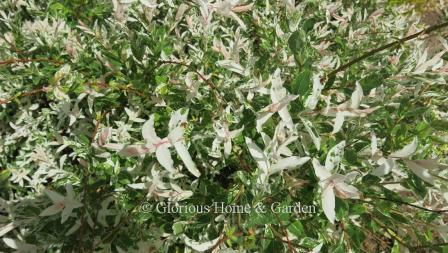 Salix integra 'Hakuro-Nishiki'
Salix integra 'Hakuro-Nishiki'Sinocalycanthus chinensis, Chinese wax plant, Zones 7-8. This charming spring flowering shrub is one of the parents of Calycanthus raulstonii 'Hartlage Wine,' Chinese wax plant is lovely in its own right with white flowers suffused with pink (but not fragrant), and large dark green leaves.
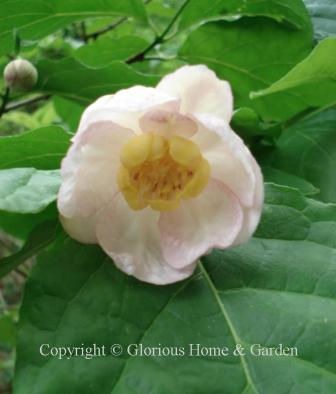 Sinocalycanthus chinensis
Sinocalycanthus chinensisSpiraea X bumalda 'Anthony Waterer,' Bumald spirea cultivar, Zones 3-8. A smallish shrub, usually about 3' to 4' high, that makes it useful in combination with other shrubs. 'Anthony Waterer' has deep pink flat-topped yarrow-like inflorescences in late spring that repeat periodically into fall. This one, in fact, was still blooming in October at the Coastal Maine Botanical Gardens.
Spiraea japonica, Japanese spirea, Zones 4-8. The mounding habit of spireas make them very easy to incorporate into the garden border or to mass in groups. One of the most popular of the Japanese spireas is 'Gold Mound' with its golden leaf color and pink flowers in spring is one of the best and it stays small at 2' - 3'. 'Shirobana' is very intriguing as white, pink and rose flowers occur together on the same plant with green leaves, also grows to a 2' -3' mounded shape.
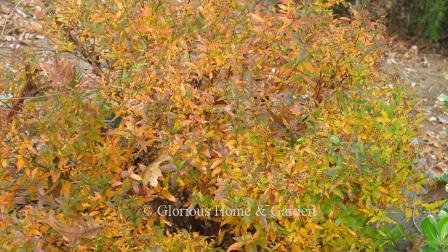 Spiraea japonica 'Neon Flash'
Spiraea japonica 'Neon Flash'Spiraea prunifolia, bridalwreath spirea, Zones 4-8. The old-fashioned bridal wreath spirea covers itself in tiny white flowers in spring. Nondescript out of bloom, it is nevertheless showy in full flower.
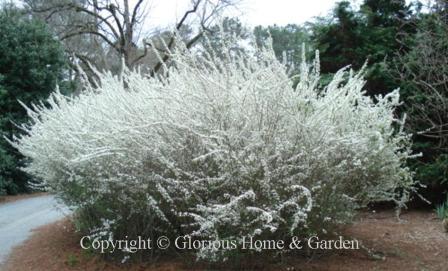 Spiraea prunifolia
Spiraea prunifoliaSpiraea thunbergii,
Thunberg spirea, Zones 4-8. This shrub is tiny in all its parts--flowers, leaves and stems. Tiny pure
white flowers cover the shrub in early spring looking like a late
snowfall. In fact, so eager to bloom is it that it will often open at the first sign of warmth in mid February in the South. 'Ogon' is a variety with golden leaves and white flowers,
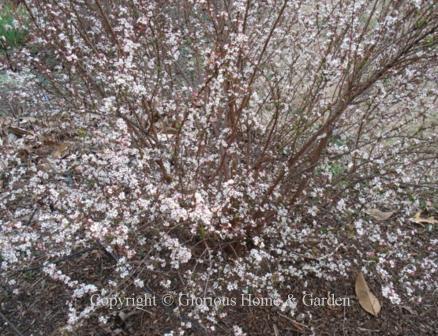 Spiraea thunbergii 'Fujino Pink'
Spiraea thunbergii 'Fujino Pink'Syringa vulgaris, common lilac, Zones 3-7. I remember staying at my aunt's house in South Carolina in the spring when her lilacs were in bloom. They were growing on the side of the house and my cousins and I were sleeping upstairs with the windows open and the fragrance pervaded the room--these spring flowering shrubs are the stuff of memories! I wish I knew which ones they were because lilacs do not usually perform well in the South. They prefer colder temperatures and so are a fixture of Northern gardens. They are best in spring for their soft colors and beautiful fragrance, but fade into the background the rest of the year. Available in white, pink, lilac (of course), blue, violet, magenta and purple, in so many different cultivars, that the thing to do is see them in bloom to choose the ones you like best. For warmer parts of the country, a few have been developed to tolerate the heat such as 'Blue Skies,' 'Lavender Lady,' and 'Miss Kim.' The hybrid Syringa x hyacinthiflora 'Excel' was also developed to bloom with less chill hours.
Syringa vulgaris 'Krasavitska Muscovy' (Beauty of Moscow) is a classic lilac with soft pink buds that open white.
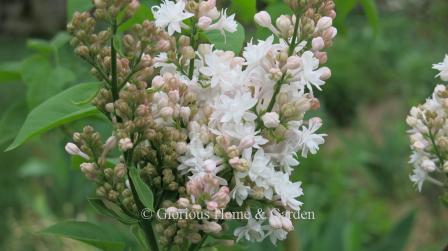 Syringa vulgaris 'Krasavitska Muscovy'
Syringa vulgaris 'Krasavitska Muscovy'For warmer parts of the country, a few have been developed to tolerate the heat such as ‘Angel White,’ 'Blue Skies,' 'Lavender Lady,' and 'Miss Kim.'
‘Excel’ is a Syringa x hyacinthiflora hybrid developed to bloom with fewer chill hours, so it is also a good one for the South.
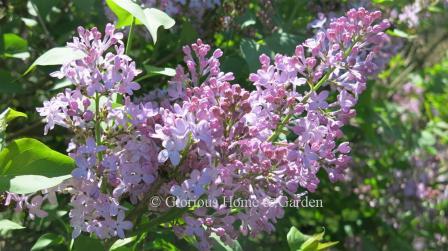 Syringa x hyacinthiflora 'Excel'
Syringa x hyacinthiflora 'Excel'Viburnums
Viburnum x burkwoodii 'Mohawk,' Burkwood viburnum, Zones 5-8. My 'Mohawk' viburnum is one of the delights of my garden, opening in late March to early April (Zone 7b). The deep pink buds open to 2-3" rounded clusters of flowers that are white inside and pink outside. The spicy fragrance is outstanding. It opens a few days later than my V. juddii, and together they perfume the garden for about a week or two. If only they could repeat! The rest of the year it is a handsome, dark green shrub of about 6' x 6' until it turns a brilliant orange-red to purple in the fall--one of the last to turn color in my garden.
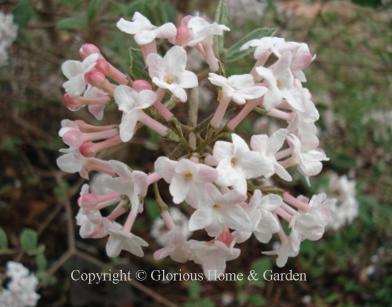 Viburnum x burkwoodii 'Mohawk'
Viburnum x burkwoodii 'Mohawk'Viburnum carlesii, Koreanspice viburnum, Zones 5-7. This is a very fragrant viburnum and a parent of 'Mohawk' and Judd's viburnums. 2-3" clusters of pinkish-red buds open white. The clusters are a little larger and whiter than 'Mohawk' or Judd's and bloom in early to mid April.
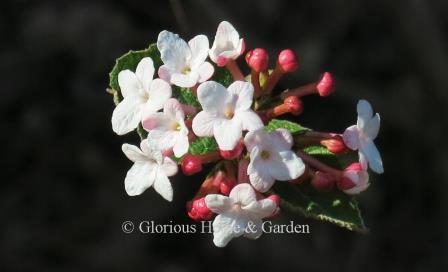 Viburnum carlesii
Viburnum carlesiiViburnum dilatatum,
linden viburnum, Zones 5-7. Blooming in late spring when most spring flowering shrubs have finished, linden viburnum is covered
with flowers resembling Queen Anne's lace. Reaching 8 - 10' at
maturity, this shrub extends the seasonal interest in the garden with
clusters of bright red fruits in the fall and leaf colors of yellow to
red. Some cultivars are 'Asian Beauty,' 'Cardinal Candy,' 'Catskill,' 'Erie,' 'Michael Dodge' with yellow berries, and 'Oneida.'
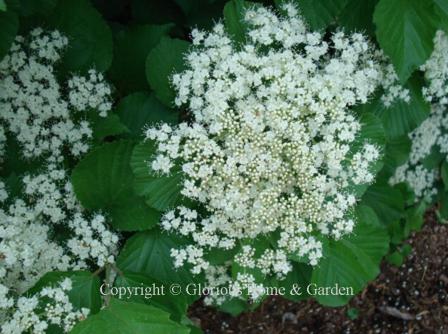 Viburnum dilatatum 'Erie'
Viburnum dilatatum 'Erie'Viburnum x juddii, Judd's viburnum, Zones 4-8. I have this shrub growing at the corner of my house and it fills the garden with delicious fragrance in early-mid April. The bloom clusters tend to be a little smaller than 'Mohawk,' and the individual flowers are white with just a tinge of pink on the underside. This is also an excellent shrub for outstanding fall color.
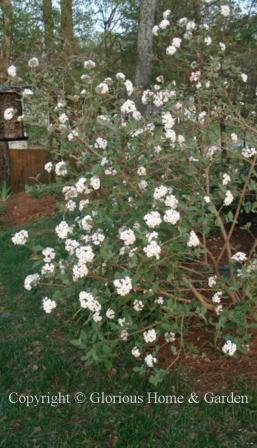 Viburnum x juddii
Viburnum x juddiiViburnum macrocephalum, Chinese snowball viburnum, Zones 6-9. This plant is quite literally smothered with huge balls of sterile flowers in spring that open lime green and mature to white. A dramatic, attention-getting, spring flowering shrub. But beware, this spring flowering shrub can get quite large (10-20' h. with a similar spread depending on location) and needs room to spread or it will tend to overwhelm anything around it. It is handsome with the lower limbs pruned to
make a small tree. The sterile flowers do not set fruit.
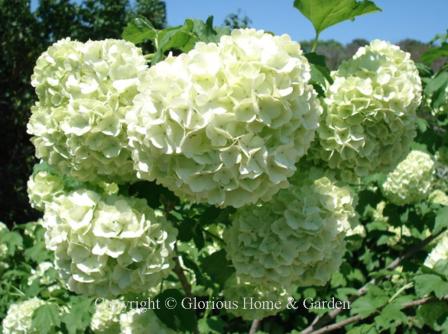 Viburnum macrocephalum
Viburnum macrocephalumViburnum opulus, European cranberrybush viburnum, Zones 3-8. European cranberrybush viburnum has white flowers in mid-spring on a shrub of about 8-15' in height with similar spread. Bright red berries are produced in the autumn. The showiest form is 'Roseum' with snowball-like flower clusters that change from green to white rather like V. macrocephalum, but not as large.
Viburnum plicatum var. tomentosum, doublefile viburnum, Zones 5-7. Many of the viburnums are fragrant, however, the doublefiles are not. The habit of the blooms carried on the tops of the branches gives it a tiered or layered effect that is as lovely as a dogwood. 'Mariesii,' 'Shasta,' and 'Summer Snowflake' are good ones to try. A very exciting new cultivar, 'Popcorn,' has fluffy round balls of white and is spectacular in full bloom. The first picture below is the typical doublefile showing its tiered branching effect; the second is 'Popcorn.'
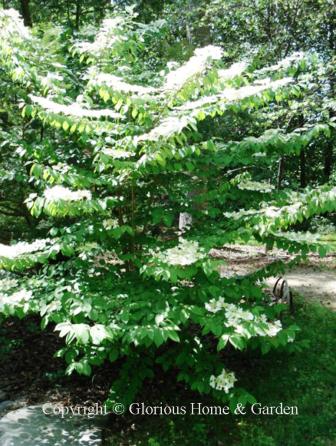 Viburnum plicatum var. tomentosum 'Mariesii.'
Viburnum plicatum var. tomentosum 'Mariesii.'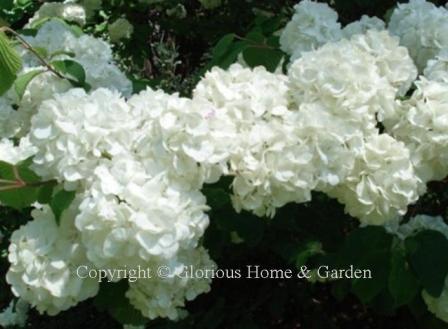 Viburnum plicatum var. tomentosum 'Popcorn'
Viburnum plicatum var. tomentosum 'Popcorn'Viburnum setigerum, tea viburnum, Zones 5-7. Tea viburnum is so called because one can make a tea from the leaves. White flowers occur in mid-spring; leaves are a handsome bluish-green, sometimes with burgundy tints. Plants will grow well in full sun to partial shade. The red berries in fall are beautiful and an ornamental asset to the garden.
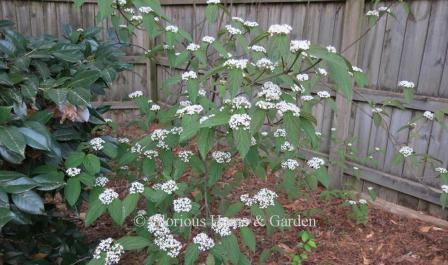 Viburnum setigerum
Viburnum setigerumViburnum sieboldii, Siebold viburnum, Zones 4-7. This can become a very large shrub from 15 to 20' or more in height, so care should be taken where it is sited. The white flowers are produced very generously completely covering the plant. Rose-red fruits in the autumn that birds relish.
Weigela florida, weigela, Zones 6-8. Weigela is a sort of old-fashioned spring flowering shrub that is nice to have for color as it blooms a little after the main onslaught of spring bloom. Easy to
grow in full sun with good drainage. Colors
include white, yellow, pink, rose, red and lavender. There are also some new cultivars with dark purple foliage such as 'Spilled Wine' and 'Wine and Roses.'
''Champagne and Strawberries' has pinkish-red flowers and green leaves with a bit of wave to them.
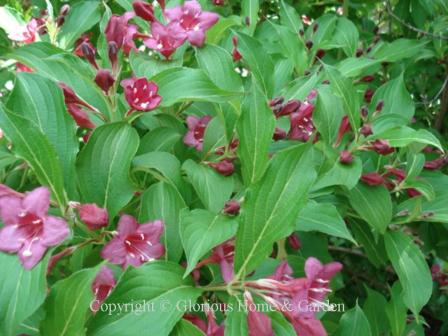 Weigela florida 'Champagne and Strawberries'
Weigela florida 'Champagne and Strawberries''Eva Rathke' is a cultivar from 1892 with deep pink flowers.
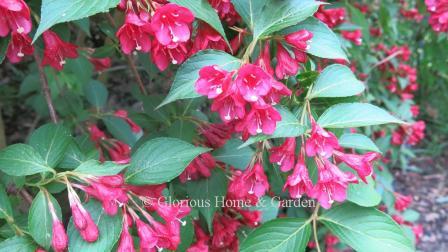 Weigela florida 'Eva Rathke'
Weigela florida 'Eva Rathke''Variegata' has pink flowers with white interiors; leaves are edged in cream. 'My Monet®,' has whiter leaf edges and blooms which are all pink.
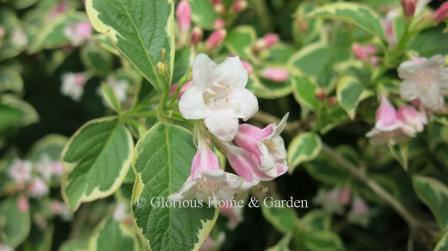 Weigela florida 'Variegata'
Weigela florida 'Variegata'Click here for spring flowering shrubs A - E.
Click here for spring flowering shrubs F - P.
Plant of the Month
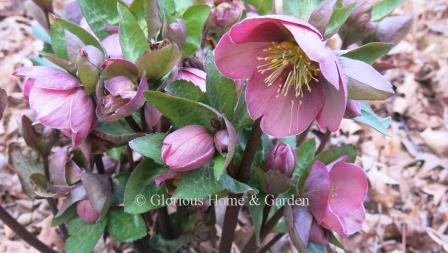
Helleborus x iburgensis
'Pippa's Purple'
Updated new USDA Plant Hardiness Zone Map 2023.